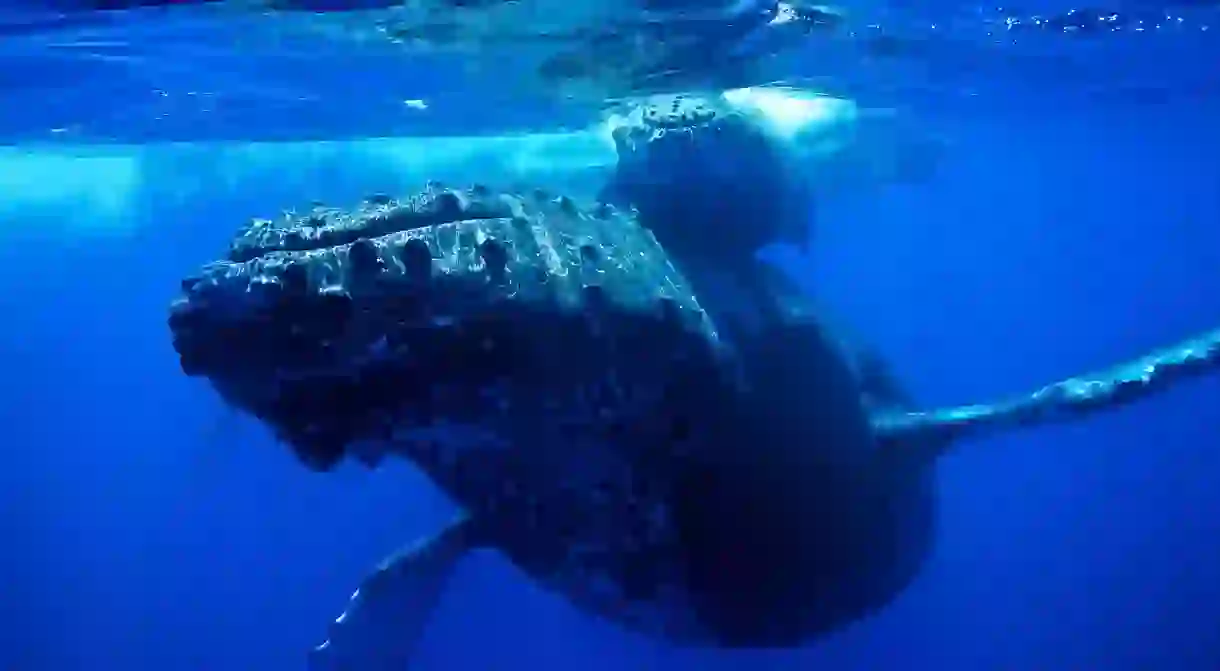A Guide to Whale Watching in Hawaii

The Hawaiian people have always had a special connection to the natural world around them.
Animals such as the kohola (humpback whale) are no exception. Kohola have been mentioned in chants, depicted in ancient petroglyphs, and are a prevalent ʻaumakua (family god). Since thousands of humpback whales visit Hawaii each year, it’s not uncommon to suddenly see a spout of water out on the horizon. Viewing one of the planet’s largest animals jump out of the water or give a pec slap is a breathtaking sight to see. Luckily, these once nearly-extinct whales are easy to view in the Aloha State.

When to go
For many months, humpback whales feed on small fish and krill near Alaska to store up reserves for the coming migration. They then travel thousands of miles to Hawaii to give birth in the warm, shallow water, and can be seen between November and May. Females only give birth to one calf, which they will bring back with them to Alaska to feed and raise for up to a year.
During the 1960s, humpback whale populations saw a drastic decline due to the whaling industry. Thankfully protective statues have stabilized the situation, but these gentle giants continue to face threats from entanglement in fishing nets, severe noise pollution, and litter among other hazards. If you’d like to volunteer, the Sanctuary Ocean Count project gathers at locations on all the Hawaiian Islands during the last Saturday of January, February, and March—the peak of whale season—to monitor and count the humpback populations.

Whale watching from shore
Oʻahu
On Oʻahu, it’s best to hike up to the Makapuʻu Lighthouse or Hanauma Bay, where there’s an expansive view of the ocean from above. The whales like to hang out in the channel between Oʻahu and Molokaʻi, making these two locations on the southeast shore the perfect place to spot them.
Kauaʻi
Kilauea Lighthouse and the Nā Pali Coast are two spectacular places to visit at all times, but especially during whale season. From these vantage points, it’s easy to spot a spout of water off in the distance if you’re not too busy marveling over the incredible coastal cliffs.

Maui
The Valley Isle is one of the best places to see humpbacks due to the shallow waters and inter-island channels surrounding it. Visitors to any beach or lookout on Maui’s west or south shores often see whales throughout the season.
Lanaʻi
The shallow, well-protected waters of the ʻAuʻau Channel is encircled by the islands of Maui, Lanaʻi, and Molokaʻi. Although it’s only around 10 miles wide, it is a favorite spot for humpback whales and their newborns. Any area along Lanaʻi’s northeast-facing shores will have the highest probability of seeing whales.
Boat tours
Visit any harbor and there are bound to be a few boats going out to view the humpbacks up close in the open ocean. Whale-watching tours are the most popular on Oʻahu and Maui, but can be booked on most of the islands. These giant animals are guarded under the Marine Mammal Protection Act which states that no one is to come within 100 feet of the animals so not to bother them and their nursing newborns. But sometimes the whales will glide right by your boat and provide you with an intimate look at the 40-ton adults and their calves.

Tips
Make sure not to forget binoculars. Often, the humpbacks will swim in the channels between the islands, which are quite far away. With binoculars in hand, you’ll have an up-close look at every tail slap and breach. Remember that the whales can hold their breath from anywhere between five and 15 minutes, so if they disappear, make sure to scan the horizon for when they pop back up for air. Lastly, patience is key for whale watching. It may take some time before a whale decides to make an appearance, so be prepared to wait it out.













